នៅក្នុងអត្ថបទមុន យើងបានរៀបរាប់ច្រើនមកហើយអំពីទម្រង់ឈររបស់ទេពនិករនៅក្នុងសិល្បៈខ្មែរ។ ដោយឡែក នៅក្នុងអត្ថបទនេះវិញ យើងនឹងរៀបរាប់បន្ថែមទៀតអំពីទម្រង់អង្គុយរបស់ទេពនិករនៅក្នុងសិល្បៈខ្មែរវិញម្តង។ តើទម្រង់អង្គុយរបស់ទេពនិករនៅក្នុងសិល្បៈខ្មែរ មានឈ្មោះហៅយ៉ាងដូចម្តេចខ្លះ? តើទម្រង់អង្គុយទាំងនេះមានឥទ្ធិពលមកពីសិល្បៈណា?
១. សុខសន (sukhasana)
សុខសន សំដៅលើការអង្គុយមួយប្រភេទដែលដាក់ដងខ្លួនត្រង់ទៅលើ ជើងឆ្វេងបត់រាបស្មើចូលក្នុង ជើងស្តាំដាក់សំយ៉ុងចុះក្រោម (មិនសំយ៉ុងត្រង់ តែជើងងាកមកចំកណ្តាល) ដែលមើលទៅហាក់ដូចជាកំពុងមានសភាពធូរស្រាល ឬពុំមានមន្ទិលអ្វីទាំងអស់។ ជាទូទៅ ឥរិយាបថរបៀបនេះនៅក្នុងព្រហ្មញ្ញសាសនា គេច្រើនតែឃើញឥរិយាបថរបស់ព្រះឥសូរ និងព្រះវិស្ណុ។ នៅក្នុងសិល្បៈខ្មែរ ឥរិយាបថបែបនេះគេមិនសូវនិយមឆ្លាក់នៅសម័យមុនអង្គរទេ (មានតិចតួច) ប៉ុន្តែនៅសម័យអង្គរវិញ យើងឃើញមានភាពពេញនិយមច្រើន។ ឧទាហរណ៍ ចម្លាក់ទេព (ព្រះឥន្រ្ទ?) នៅលើផ្តែរប្រាសាទអូរផ្អុង ចម្លាក់ព្រះឥសូរឆ្លាក់នៅហោជាងប្រាសាទបន្ទាយស្រី។

២. លាលីតសន (lălĭtasana)
លាលីតសន សំដៅលើឥរិយាបថអង្គុយមួយប្រភេទដែលដាក់ជើងម្ខាងបឈ្ឈរជង្គង់នៅលើជើងទម្រ ជើងម្ខាងទៀតដាក់ដោយសេរីដែលមើលទៅដូចធូរស្រាល ហើយជាទូទៅកាយវិការរបៀបនេះមើលទៅស្រដៀងកាយវិការមហារាជលីលាសន។ នៅក្នុងសិល្បៈឥណ្ឌា ឥរិយាបថនេះច្រើនតែបង្ហាញជាទេពវិនយក (ព្រះគណេស)។ ចំណែក នៅក្នុងសិល្បៈខ្មែរ ការអង្គុយរបៀបនេះ មានបង្ហាញតាំងពីស.វ.ទី៧មកម្ល៉េះ ជាក់ស្តែង រូបកាល-ភៃរវ (?) នៅប្រាសាទសំបូរ តួប៉ម N1 នៃតំបន់ប្រាសាទសំបូរព្រៃគុក។
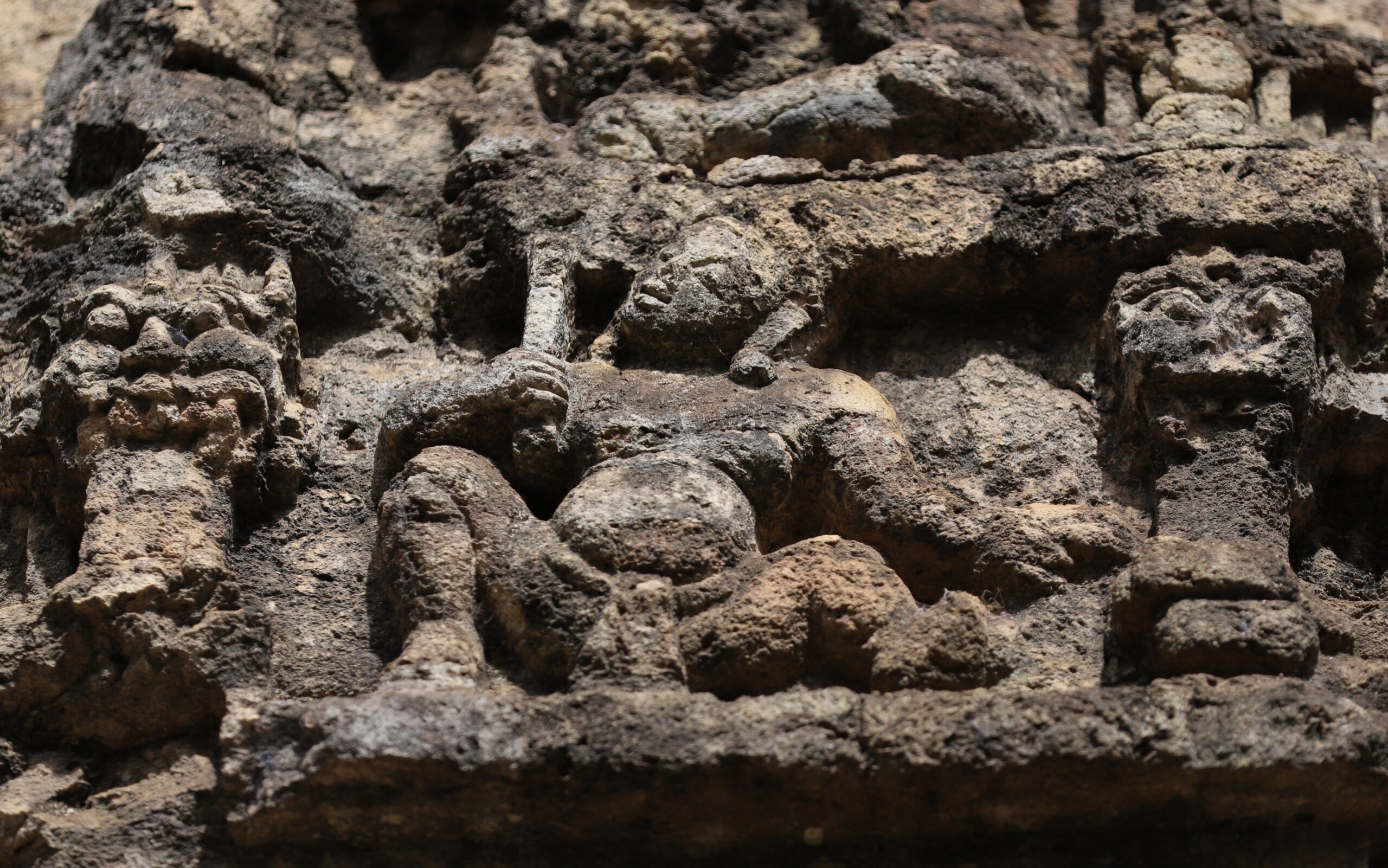
៣. មហារាជលីលាសន (mahărăja lĭlăsana)
មហារាជលីលាសន សំដៅលើការអង្គុយដោយដាក់ជើងស្តាំបញ្ឈរជង្គង់ ជើងឆ្វេងបត់រាបស្មើដោយម្រាមជើងឆ្វេងមកជាប់ជាមួយកែងជើងស្តាំ ដៃស្តាំដាក់លើជង្គង់ជើងស្តាំ និងដៃឆ្វេងទម្លាក់ចុះដីឬដាក់នៅលើភ្លៅឆ្វេង។ ឥរិយាបថនេះ ដងខ្លួនអាចផ្អៀងបានតាមចិត្ត ខុសពីឥរិយាបថកាយវិការសុខសនដែលត្រូវដាក់ឱ្យត្រង់។ មហារាជលីលាសន ជាឥរិយាបថតំណាងឱ្យការបន្ធូរអារម្មណ៍ ឬភាពអស្ចារ្យ។ នៅក្នុងសិល្បៈឥណ្ឌា ឥរិយាបថរបៀបនេះមិនត្រឹមតែមានចំពោះទេពក្នុងព្រហ្មញ្ញសាសនាប៉ុណ្ណោះទេ សូម្បីតែទេពនៅក្នុងព្រះពុទ្ធសាសនាក៏មានដែរ ឧទាហរណ៍ ព្រះពោធិសត្វ និងសិមហនាថលោកេស្វរ។ ដោយឡែក នៅក្នុងសិល្បៈខ្មែរ ការបង្ហាញឥរិយាបថមហារាជលីលាសនមានការពេញនិយមខ្លាំងតាំងពីស.វ.ទី៧មកម្ល៉េះ ជាពិសេសយើងច្រើនឃើញចម្លាក់ទេពដែលឆ្លាក់នៅលើវិមានអណ្តែត។ នៅសម័យអង្គរវិញ កាយវិការរបៀបនេះក៏នៅតែមានភាពពេញនិយម ដូចរូបចម្លាក់តួអង្គសន្តតិវង្សបណ្ឌវ នៃរឿងមហាភារតនៅប្រាសាទបន្ទាយស្រីជាដើម។
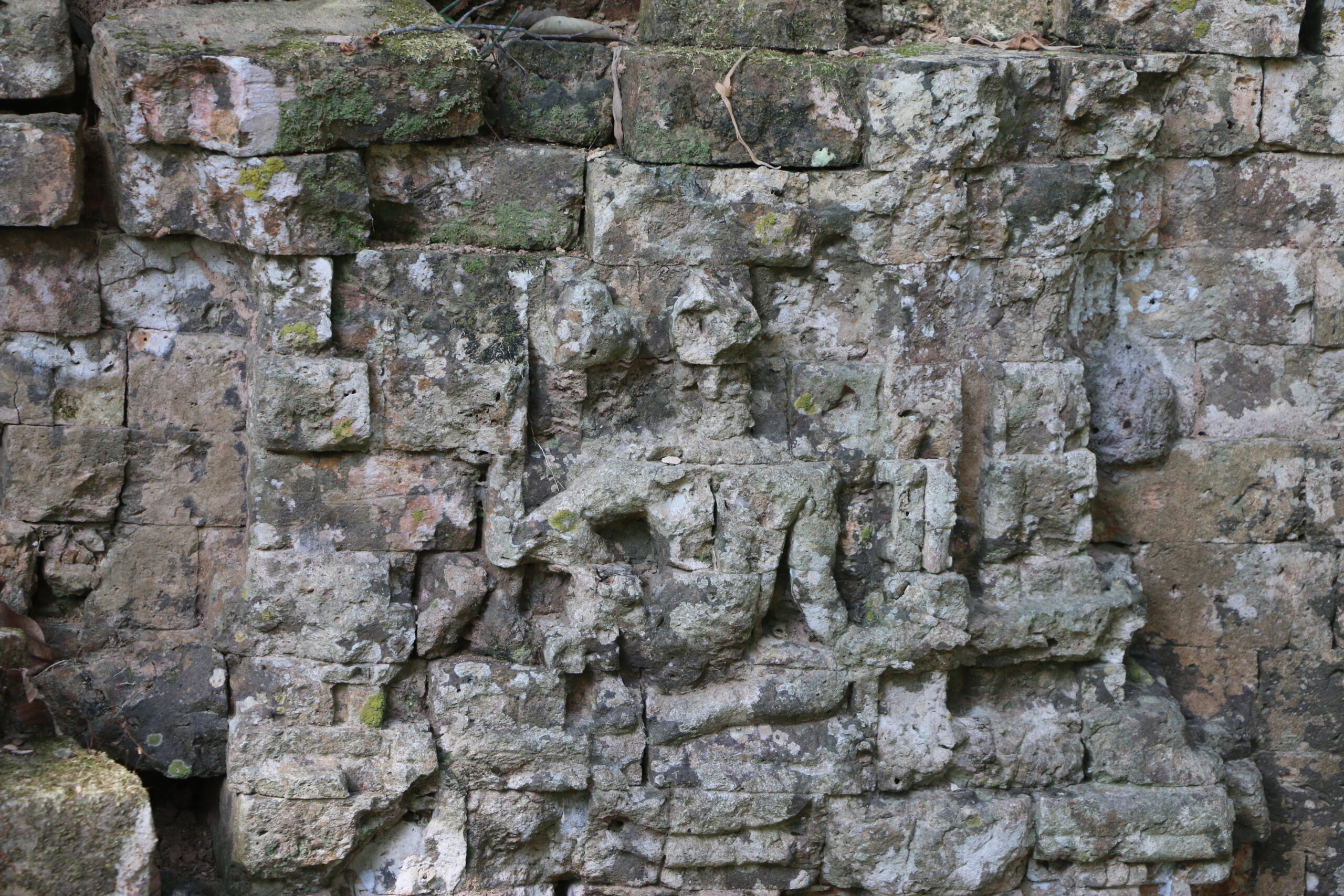
៤. បទ្មសន (padmasana)
បទ្មសន សំដៅលើការអង្គុយដោយដាក់ជើងទាំងពីររាបស្មើមកត្រួតលើគ្នា ដែលនៅក្នុងប្រពៃណីខ្មែរនិយមហៅថា “ពែនភ្នែន” ហើយ “បទ្ម” មានន័យថា “ឈូក”។ ឥរិយាបថបទ្មសន គេអាចហៅម្យ៉ាងទៀតថា “កមលសន” ហើយបើនៅក្នុងព្រះពុទ្ធសាសនាវិញគេនិយមហៅថា “បយ៌ន្កសន” និង “វជ្រសន”។ ក្នុងនោះ ប្រសិនបើជើងឆ្វេងបត់ដាក់រាបស្មើ ហើយជើងស្តាំដាក់ប្រអប់ជើងទៅលើភ្លៅជើងឆ្វេង គេអាចហៅម្យ៉ាងទៀតថា “អថ៌បទ្មសន”។ កាយវិការបែបនេះ នៅក្នុងសិល្បៈខ្មែរគេនិយមខ្លាំង ពោល គឺទាំងទេពនៅក្នុងព្រហ្មញ្ញសាសនា និងព្រះពុទ្ធសាសនា។ ជាក់ស្តែង បដិមាព្រះពុទ្ធរូបអភយមុទ្រ ស.វ.ទី៦ រកឃើញនៅវត្តកំពង់ហ្លួង ស្រុកអង្គរបុរី ខេត្តតាកែវ រូបព្រះពុទ្ធសមាធិ ស.វ.ទី៦ រកឃើញនៅស្រុកគងពិសី ខេត្តកំពង់ស្ពឺ និងរូបព្រះនាងកាលិ ស.វ.ទី១០ រកឃើញនៅប្រាសាទធំ តំបន់កោះកេរ ជាដើម។
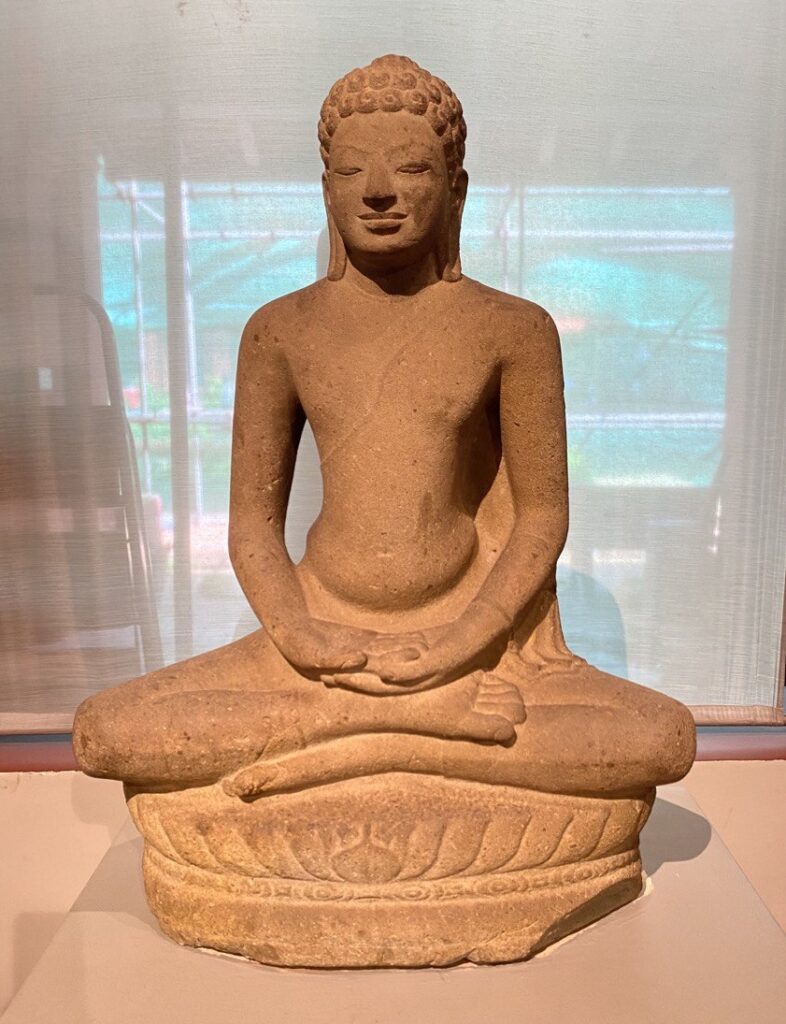
បទ្មសន រកឃើញនៅស្រុកគងពិសី ខេត្តកំពង់ស្ពឺស.វ.ទី៦
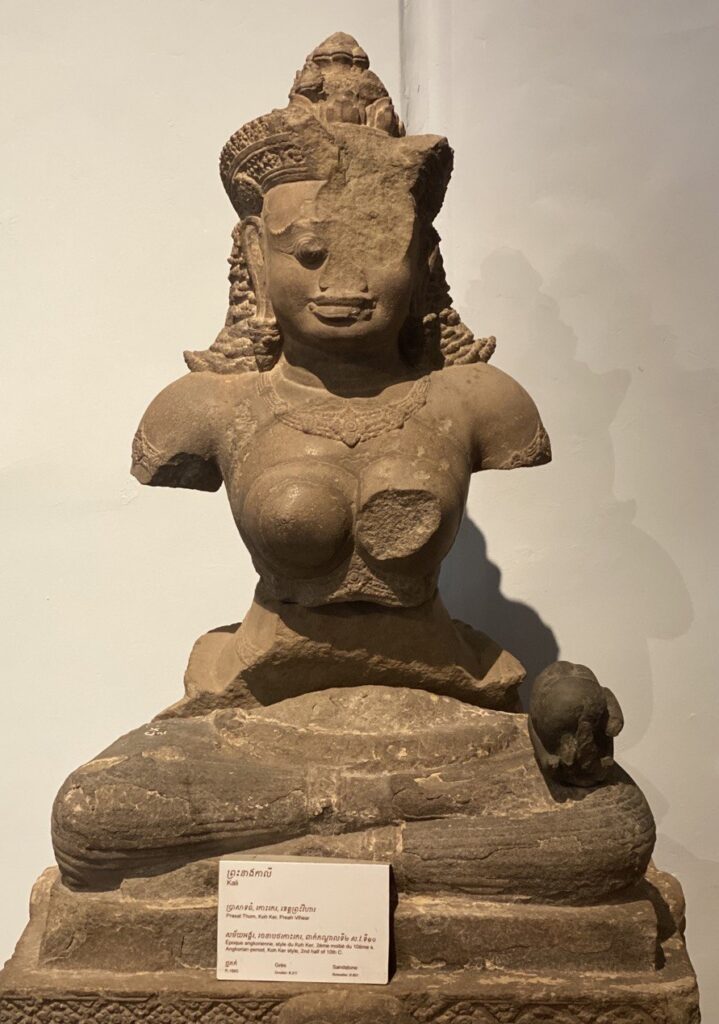
បទ្មសន នៅប្រាសាទធំ កោះកេរ ស.វ.ទី១០
៥. យោគសន (yogasana)
យោគ មានន័យថា ការសមាធិដោយវិញ្ញាណឱ្យមានវិន័យ ដែលចិត្តត្រូវផ្តោតទៅលើទេវ និងចិត្តត្រូវមានភាពរីករាយ។ ចំណែក យោគសន សំដៅលើការអង្គុយស្រដៀងឥរិយាបថបទ្មសន ពោល គឺជើងទាំងពីរដាក់បញ្ឈរជង្គង់ដោយបាតជើងទាំងពីរដាក់ខ្វែងគ្នា ហើយចងព័ទ្ធដោយក្រណាត់មួយដែលគេហៅថា “យោគបត្ត”។ ឥរិយាបថរបៀបនេះបង្ហាញអំពីការប្រៀនប្រដៅវិញ្ញាណទាំងប្រាំ ដែលជាទូទៅក្បាលត្រូវដាក់ឱ្យត្រង់ ភ្នែកសម្លឹងមើលចុងច្រមុះ ដៃទាំងពីរពេលខ្លះលើកប្រណម្យ និងខ្លះដាក់ទៅមុខ ឬដាក់លើភ្លៅក៏មាន។ កាយវិការនេះ ប្រសិនបើមិនមានខ្សែក្រណាត់ព័ទ្ធជើងទាំងពីរគេអាចហៅម្យ៉ាងទៀតថា “ស្វស្តិកសន”។ នៅក្នុងសិល្បៈខ្មែរកាយវិការរបៀបនេះ ច្រើនបង្ហាញជារូបឥសី ដែលយើងឃើញដំបូងគេនៅសំបូរព្រៃគុក ស.វ.ទី៧ ឆ្លាក់នៅវិមានអណ្តែត ហើយនៅសម័យអង្គរវិញ គេនិយមឆ្លាក់តាមជើងសសរពេជ្រ និងខ្លះទៀតឆ្លាក់ជាបដិមាទោលក៏មាន។
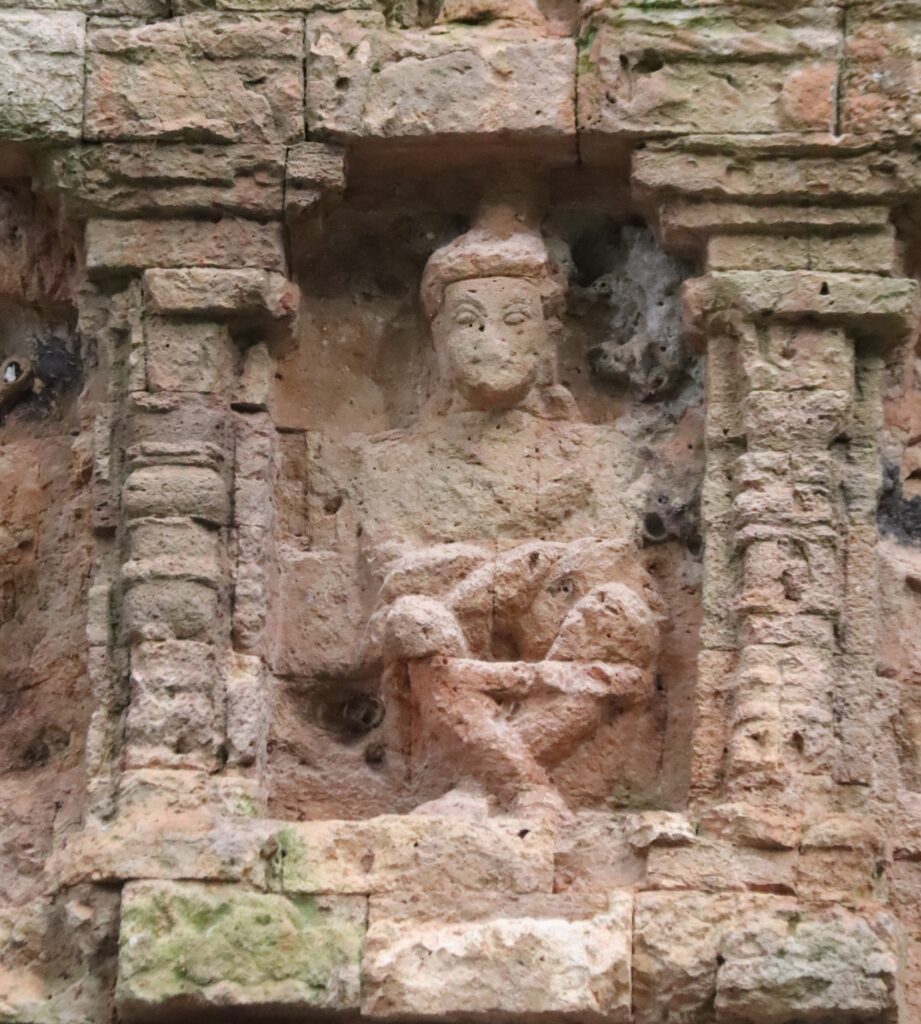
នៅសំបូរព្រៃគុក N11 ស.វ.ទី៧ (រូបថត៖ ឯម ភារក្ស)

នៅជើងសសរពេជ្រប្រាសាទបន្ទាយសំរ៉ែ ស.វ.ទី១២

នៅប្រាសាទព្រះគោ ស.វ.ទី៩
ក្រៅពីទម្រង់អង្គុយខាងលើ នៅមានទម្រង់ជាច្រើនទៀត ដែលមិនសូវនិយមឆ្លាក់នៅក្នុងសិល្បៈខ្មែរ ដូចជា គរុឌសន (garuḍasana) រាជលិង្គសន (răjaliṅgasana) វិរសន (virasana) ឧត្កុតិកសន (utkutikasana)។ល។
ជារួមមក ទម្រង់អង្គុយរបស់ទេពនៅក្នុងសិល្បៈខ្មែរមានលក្ខណៈសម្បូណ៌បែបណាស់ ហើយទម្រង់ទាំងនោះ ស្ទើរតែទាំងអស់ខ្មែរបានទទួលឥទ្ធិពលពីសិល្បៈឥណ្ឌា។ ទម្រង់អង្គុយនីមួយៗ សុទ្ធសឹងមានអត្ថន័យនិងផ្នត់គំនិតខាងក្នុង។ យ៉ាងណាក៏ដោយ ឥរិយាបថនៃការអង្គុយរបស់ទេពដែលបានបង្ហាញខាងលើ គ្រាន់តែជាការបង្ហាញទម្រង់ខ្លះៗប៉ុណ្ណោះ៕
————————————
Sitting posture of the Gods
The first part of the article illustrated the standing postures of the Gods. However, in this part will be shown the sitting postures. What is the name of the sitting postures of the Gods? Where do they come from?
Sukhasana
Sukhasana refers to sitting straight, the left leg bends in, and the right leg puts down. Generally, this position is shown in the posture of Hindu Gods such as Lord Shiva and Vishnu. In Khmer Arts, this position was rare in the pre-Angkorian period. However, it was common in the Angkorian period. For instance, Indra on a lintel of Prasat O Paong and Shiva on a lintel of Prasat Banteay Srei.
Lălĭtasana
Lălĭtasana refers to sitting with one leg on the pedestal and another leg resting freely. This position is similar to Mahărăja lĭlăsana. In Indian art, this position is usually present in the statue of Ganesha. In Khmer arts, this position appeared in the pre-Angkorian period of the 7th century. For example, the figure of Bhairava from a temple in Sambo Prei Kuk, N1.
Mahărăja lĭlăsana
Mahărăja lĭlăsana is a position of sitting with the right leg in a squad position and the left leg bending on the floor. Significantly, the toes of the left foot touch the right heel. The right hand is on the right knee, and the left hand is on the left thigh. This position shows relaxation and power. In Indian arts, this position adopts both the posture of Hindu and Buddhist icons. However, in Khmer arts, Mahărăja lĭlăsana was popular from the 7th century. Remarkably, the deities in the flying temple. In the Angkorian period, this position was significantly popular. For instance, it presents the figure of Pandava from Mahabharata in the Banteay Srei temple.
Padmasana
Padmasana is a sitting with putting the leg on one another. It is called Pen-Phnen in Khmer. The Padma means lotus. This position is known as Kamalasana or Paryanakasana or Vajrasana in Buddhism. The left leg bends and rests on the floor, and the right leg is on the left thigh. It could be called Ardha Padmasana. This position is commonly present in Khmer arts, especially for Buddhist icons. For instance, the 6th century Buddha with Abhayamudra from Kampong Loung pagoda, Angkor Borei, Kampong Speu province, and Kali of 10th century in Prasat Thom, Koh Ker.
Yogasana
Yoga is a meditation that focuses on God and pleasant feelings. Yogasana refers to the sitting position that is similar to Padmasana. However, it raps up by a piece of cloth called Yogabatta. The head must be straight, the eyes look into the tip of the nose, and both hands pray or put on the thigh. If there is no piece of cloth to tie, it is called Swastikasana. In Khmer arts, this position appeared in the 7th century. In the Angkorian period, it is commonly shown on the bottom of the small column, and some are on the statues. There are some sitting positions that are rare in KhmSome sitting positions areṅgasana, Virasana, and Utkutikasana There are many sitting positions shown in Khmer arts. Most of them were influenced by Indian art. Also, the significance of the sitting positions is their meaning.
អត្ថបទដោយ៖ លោក ម៉ង់ វ៉ាលី






